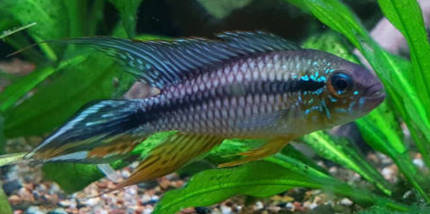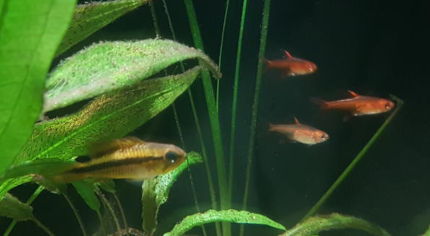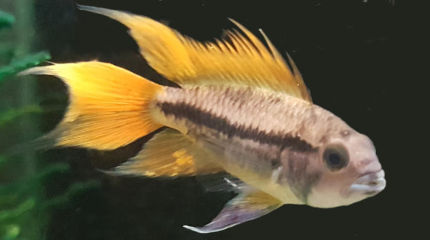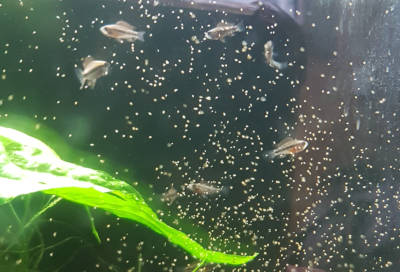Apistogramma Dwarf Cichlids are interesting and colourful fish with great personalities which is why many people enjoy keeping them in their aquariums.
This Apistogramma Dwarf Cichlids care guide will help you to successfully keep these wonderful fish.
About Apistogramma Dwarf Cichlids
General Apistogramma Profile
Origin: Varys depending on species, South America, Amazon basin including Brazil, Peru, Argentina.
Size: Female 2 to 2.4 inches (5 - 6 cm) depending on species. Male 3 - 3.5 inches (7.7 - 8 cm) depending on species
Minimum tank size: 10 or 15 gallons (38 or 55 litres) depending on species
Tank region: Bottom region to bottom half of the tank.
Water temperature: 20 to 29 °C (68 - 85 °F) depending on species
Water conditions: Neutral slightly acidic water with PH between 6 to 7 is desirable. Soft water with a low TDS is preferred. Commercial bred varieties are less fussy.
Difficulty to keep: Intermediate
There are a range of different Apistogramma species within the genus, which originate from various parts of South America. Many including Cacatuoides and Agassizii are from the amazon basin and the many tributaries feeding it, this includes parts of north western Brazil and Peru. Whilst other species such as Borellii are from southern Brazil, Paraguay and northern Argentina.
Apistogramma inhabit slow moving tributaries and creeks which are often partly shaded and can contain leaf litter. The water itself maybe clear or brackish due to tannins. These tributaries usually have a sandy bottom.
Behaviour and Personality
Like many dwarf cichlids Apistogramma are smart fish and have a great personality, they are curious and take an interest in their surroundings and what is going on.
They are generally peaceful but can become territorial and aggressive when breading. For tips on reducing aggression see our article Apistogramma Aggression And How To Reduce It.
Apistogramma can be kept in a community tank with other peaceful fish such as many species of tetras or Corydoras catfish. In a community tank you could keep a sole male as a center piece fish or a male with 2 or 3 females, however the tank should be laid out in a suitable manner (see Aquarium Layout).
Types of Apistogramma
Apistogramma Species
There are many different species of Apistogramma, some of the more common varieties are:
- Cacatuoides
- Agassizii
- Borellii
- Trifasciata
- Nijsseni
- Panduro
- Macmasteri
- Hongsloi
- Viejita
The exact origin and size of the fish, coloration and markings differ between the species though their habitat and diets are similar. Hence for keeping Apistogramma in aquariums the general requirements are generally the same regardless of species.
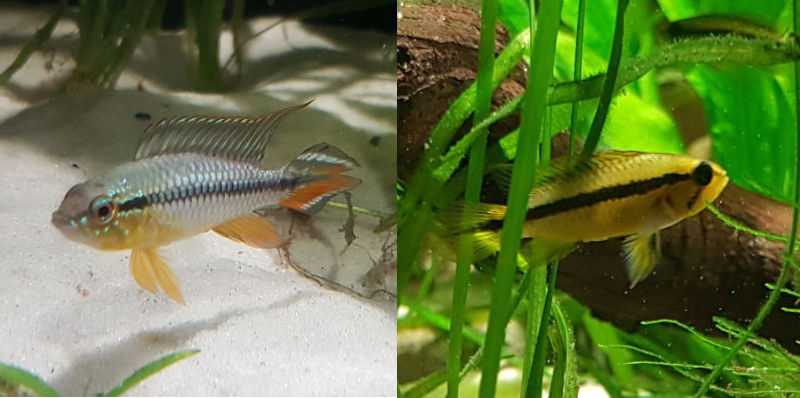
Apistogramma Colour Variants
A number of Apistogramma domestic colour strains have emerged in the aquarium hobby as the popularity of Apistogramma's has increased. These colour strains are the result of selective breeding and are most common in Apistogramma Cacatuoides and Apistogramma Agassizii. Popular colour strains include double red, triple red & orange flash.
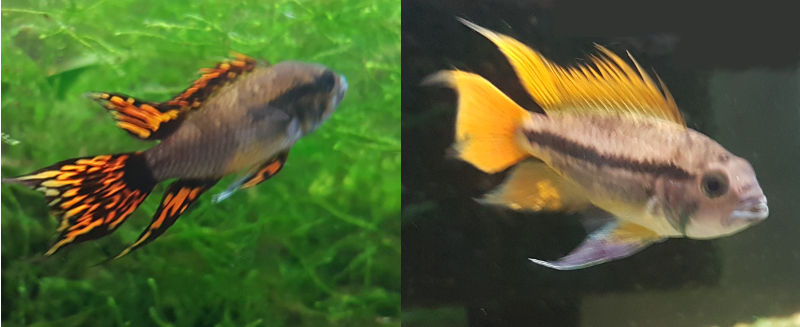
Apistogrammas In Community Tanks
When keeping Apistogramma in a community tank it is recommended to only keep one species. This prevents any inter species aggression.
Apistogramma also prefer to be kept in pairs or harems with a single male and 2 to 3 females. This also avoids aggression between males. It is recommended to have at least a 20 gallon (75 litre) aquarium.
To keep a larger group with multiple males such as 2 males and 6 female requires more careful planning and a larger tank.
To keep 2 males we suggest at least a 40 gallon (150 litre) aquarium, preferably a 40 gallon long style which is 4 foot long.
The longer aquarium allows for more room between the males with enough room and surface area on the bottom of the tank for the males to establish their own territories.
The layout of the tank is also important, see the section further down in this article regarding aquarium layout.
Best Apistogramma Tank Mates
Other non aggressive fish are best, tetras (there are so many to choose from) and Dwarf Pencilfish are generally good choices.
Fish which originate from the same part of the world often make the best tank mates as the desired water parameters are likely to be very similar.
For more detail on selecting Apistogramma tank mates check out or detailed article, Apistogramma Tank Mates.
If you intend to breed Apistogramma dwarf cichlids then more care should be taken as some tetras and other fish will eat Apistogramma eggs!
Aquarium Setup
Tank Size
I would suggest a 10 Gallon (38 Litre) as a minimum for a trio (1 male + 2 females) of the smaller species of Apistogramma such as Borellii. But a 15 Gallon (55 Litre) as a minimum for larger species like Cacatuoides or Agassizii.
It also depends what your objective is with the tank, if you want a Apistogramma only tank or if you want a community tank with some other species such as some tetras etc. If you plan to have a community tank, then generally the larger the tank the better.
Substrate
A sand substrate is recommended Apistogramma dwarf cichlids as it mimics the Apistogramma's natural habitat.
Apistogramma's enjoy sifting the sand as they look for food on the bottom of the tank. A fine grain smooth sand is recommended (such as pool filter silica sand).
Gravel, dirt or other substrate can be used at the very bottom (which can be beneficial for plants) with a 3-4cm top layer of sand.
Aquarium Layout
Apistogramms appreciate some hiding places around the aquarium and breaks in line of sight should they want to either get away from other fish or defend part of the tank as their territory - this is particularly the case when breeding.
Hiding places and breaks in line of sight can be accomplished by laying out the tank appropriately. Driftwood and rocks can be used along with ceramic caves or coconut huts. Plants can also provide some retreats and shaded areas.
Ensure the take is cycled with a working biological filter and that there is no ammonia, or nitrites and that nitrates are low before adding Apistogramma's to the tank.
Breeding tanks can have a slightly modified setup. If you are interested in breeding Apistogramma I suggest you check out the How To Breed Apistogramma Agassizii guide.
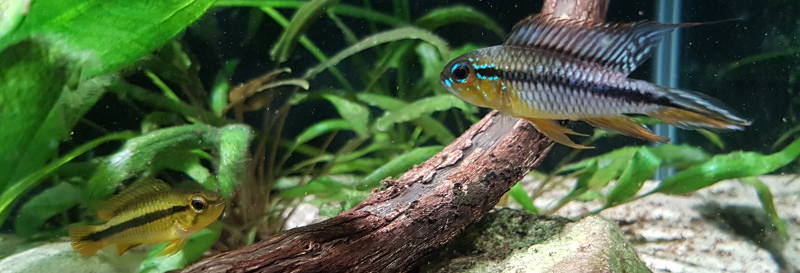
Equipment
Filter
Apistogramma prefer low to minimal flow this should be kept in mind when choosing a filter.
Matten Filters are a great option they have a large surface area for filtration, low flow and are affordable to make. They can also be customized to fit any tank. This Matten Filter guide goes into further details on Matten Filters including how to make them.
Sponge filters can also be good choice as they are cost effective and have low flow, you can use multiple sponge filters if needed, one at each end of the tank for example.
Another option is a small Hang on back (HOB) filter such as an Aquaclear 20 or 30, these maybe suitable in larger tanks or even 20 Gal tanks with the filter flow turned down to reduce the flow rate.
Heater
For a heater select the wattage aligning with the tank size being used, if unsure I suggest erring of the side of a slightly larger heater as opposed to a smaller heater.
For a 20 Gallon tank a 75W if you can find one or 100W heater are good choices. I like Ehiem heaters and have used a Eheim jager 100W heater recently in a 18 gallon tank with success. But any good quality brand name heater should suffice.
If your tank is larger ensure you purchase a heater of the correct wattage to match the size of your tank.
Lighting
As mentioned Apistogramma come from shady tributaries so lighting is not critical, in fact ambient room light is probably adequate for Apistogrammas. However, if you enjoy watching your fish or have some easy to grow plants in the tank then at least some basic lighting is probably required.
On my planted Apistogramma Agassizii tank I use a Asta 20 freshwater LED light which is one of the more affordable options. It is a pendent style light so it is possible to have it positioned so that one section of the tank is brighter and another section is more dimly lit. Floating plants can also help to reduce the light and provide shady areas within the tank.
What to Feed Apistogramma Dwarf Cichlids
Apistogramma's are omnivores and will happily eat a variety of food. A diet containing a variety of foods is recommended. Live foods are considered best and are thoroughly enjoyed by these fish however live foods are not always on hand. Although live foods are considered the best option most fish will accept frozen, flake and pallet foods.
Recommended live or frozen foods
Brine Shrimp, daphnia, mosquito lave, Blood worms, Black worms. I tend to mainly feed Brine shrimp and mosquito lave when I can find it. Do not feed blood worms or black worms very frequently as they are fatty and too rich and can cause bloat, they are ok as a treat but don't base their diet on them.
Flake or pallet food
I find sinking pellets work well for Apistogramma's. Stick to reputable brands like New Life Spectrum or Hikari. Both of these brands have sinking pallets in different sizes suitable for cichlids.
I tend to alternate between feedings, feeding live brine shrimp if I have it or else frozen brine shrimp and then for the next feeding I feed slow sinking pallets.
For more information on what to feed you Apistogrammas see our article Best Foods For Apistogrammas.
Maintenance
As with all aquariums regular maintenance is required. The level of maintenance will vary from tank to tank based on the size and stocking levels, among other things. Regular water changes to ensure nitrates do not build up are necessary along with vacuuming of the substrate to remove any leftover uneaten food or decaying plant matter.
Conclusion
Keeping Apistogramma dwarf cichlids can be an enjoyable experience especially if you take the time to provide them with an aquarium that meets their needs. Apistogramma have great personalities and can add a colourful point of interest to your aquarium.
